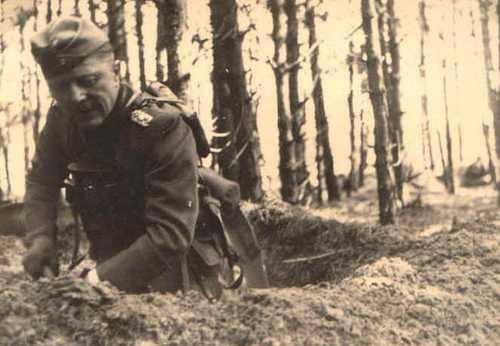
German Forces
Unlucky general.
Hans, Graf von Sponeck, as Generalmajor. In spite of the impression that he may be searching for truffles, this 'photo was in fact taken in woods near Loosduinen, a suburb of the Hague, as he presded over an action that gave one of the first indications of the limitations of large-scale airborne assaults - the Battle of the Hague. The attack took place on 10 May, 1940, at the beginning of Germany's attack on the Netherlands. The idea was that 22 Luftlande-Division - a unit composed of conventional Heer infantry trained to be landed on their target from the air, and commanded by von Sponeck - would land on a number of airfields close to the Dutch administrative capital at Den Haag, advance into the city, and capture the Dutch Royal Family and senior military staff. In principle, this was strategically sound - the Dutch military system was highly centralised, and capture of Queen Wilhelmina and General Winkelman (the Dutch commander-in-chief), as well as the administrative hub of Den Haag, would have beheaded the Dutch defensive system, and put the Germans in a strong position to demand a Dutch surrender. Good idea - unlucky execution. The German attack commenced in early morning on 10 May, 1940. It was misty over the target area, and German navigation proved indifferent - the Dutch landscape, particularly under mist, is somewhat lacking in good navigational landmarks. As a result, many of the Ju-52 transport aircraft had difficulty in identifying their targets. Many came down or crashed away from the target airfields. By the time others began to land on target, the Dutch defenders were alarmed, and many aircraft were shot down or crashed on the airfields, making it difficult or impossible for the remaining transports to land. The Germans managed to capture all the target airfields with difficulty - but were prevented from advancing into the city by Dutch resistance. Dutch counterattacks forced the Germans from the airfields, resulting in an even greater dispersal of 22 LLD. Many transports were destroyed, and many German soldiers were captured. By the time the Germans managed to capture the city, the Royal Family and the military command had fled. Von Sponeck - who had, apparently, packed his dress uniform in anticipation of a meeting with Queen Wilhelmina - was ordered to redirect his troops towards Rotterdam. The unlucky general only made it part of the way - his reduced force was surrounded by Dutch troops, and was relieved only by the final Dutch surrender. Von Sponeck did not suffer direct and immediate adverse consequences - he was wounded and, on return to Germany, was promoted to Generalleutnant and award the RK. However, he was subsequently sentenced to death for ordering a retreat on the Eastern Front in contravention of orders. The sentence was commuted to a sentence of imprisonment. However, following the 20 July 1944 assasination attempt on Hitler, von Sponeck was caught up in the Gestapo clean-up of "unfinished business" from previous "anti-Nazi" activity (Canaris, Oster et cetera), and was put to death. A very unlucky general, I think. Best regards, JR.
5498 Views
1/19/2011
